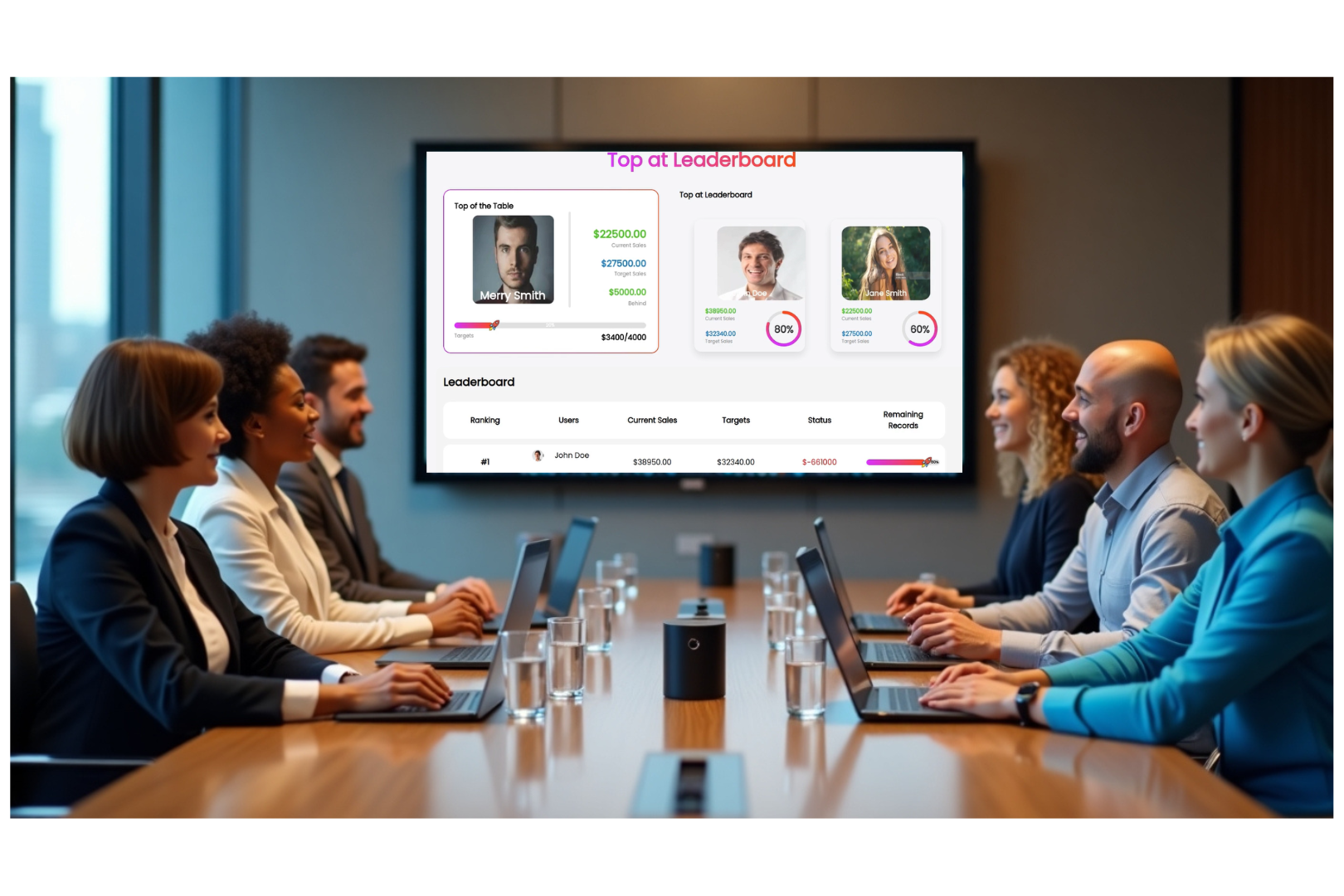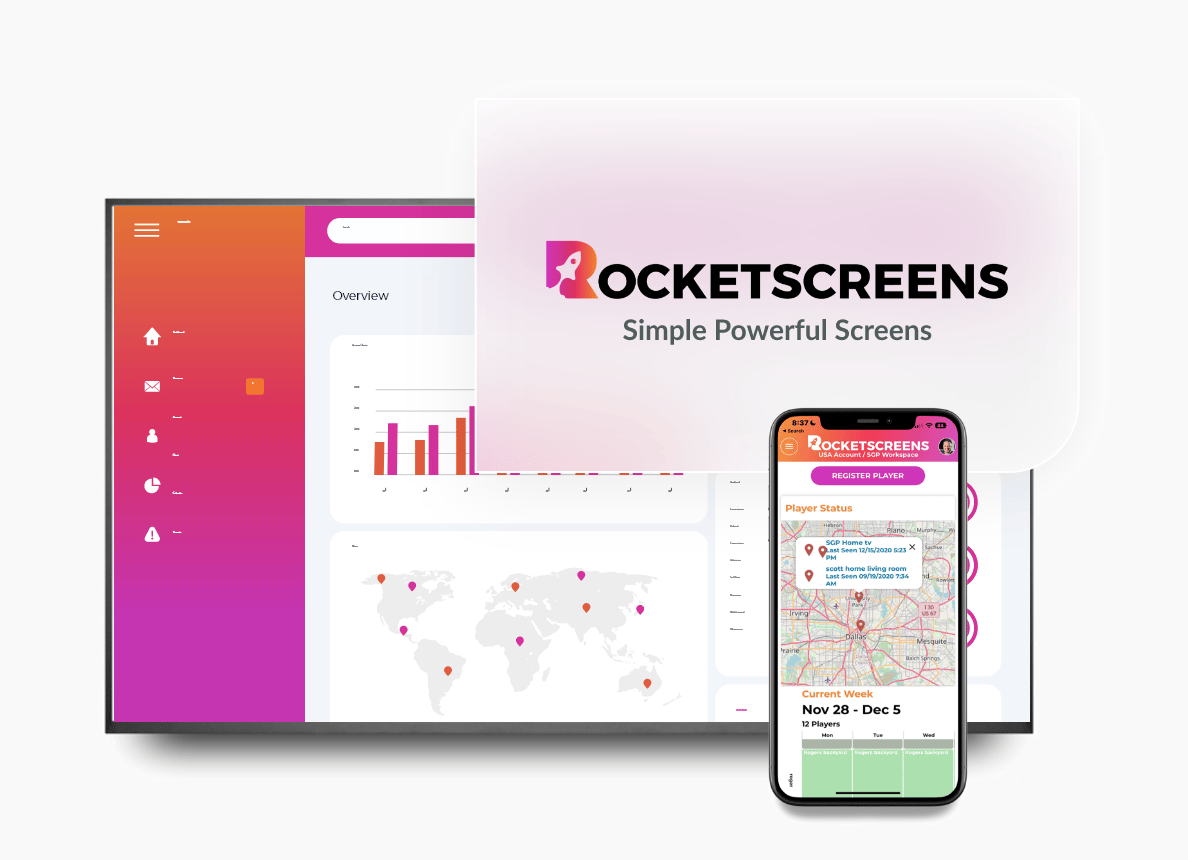
In the competitive world of sales, keeping your team motivated and engaged can be challenging. Top performers naturally thrive on competition, but how do you maintain energy across your entire sales floor? The answer might be simpler than you think: gamification in sales.
Sales gamification transforms everyday sales activities into engaging, competitive experiences that drive performance while making work more enjoyable. At the center of this approach are leaderboards – visual representations of success that tap into our natural desire for recognition and achievement.
What Is Sales Gamification?
Gamification applies game-like elements to non-game situations. In sales, this means incorporating challenges, competition, rewards, and recognition into daily work processes. The concept leverages our psychological desire for status, achievement, and rewards to boost motivation and performance.
Sales gamification isn't just about having fun – it's a strategic approach to increasing productivity, improving skill development, and ultimately driving revenue. When implemented thoughtfully, gamification creates a work environment where team members push themselves to improve because they want to, not because they have to.
Core Elements of Effective Sales Gamification
- Clear objectives: Well-defined goals that align with business outcomes
- Visible progress tracking: Real-time feedback on performance through leaderboards
- Meaningful rewards: Incentives that matter to your specific team
- Healthy competition: Structured challenges that bring out the best in everyone
- Recognition systems: Public acknowledgment of achievements and milestones
Why Leaderboards Are the Heart of Sales Gamification
Leaderboards stand at the center of successful sales gamification strategies. These visual performance trackers display real-time rankings based on predetermined metrics, creating transparency and healthy competition within teams.
The Psychology Behind Leaderboard Effectiveness
Leaderboards work because they tap into fundamental human motivators:
- Social comparison: People naturally gauge their performance against peers
- Recognition: Public acknowledgment of achievements boosts confidence and satisfaction
- Progress visualization: Seeing advancement motivates continued effort
- Competitiveness: The desire to climb rankings drives increased activity
- Goal clarity: Leaderboards provide clear targets to aim for
Research shows that 89% of employees say gamification makes them more productive at work, while 88% report feeling happier when using gamified systems. The visual nature of leaderboards makes progress and success immediately apparent, creating instantaneous feedback loops that traditional management approaches can't match.
Implementing Leaderboard Gamification in Your Sales Organization
Creating an effective leaderboard system requires thoughtful planning. The most successful implementations consider these key factors:
Choose the Right Metrics
The metrics you track on leaderboards should:
- Align with company objectives
- Be clearly measurable
- Reflect both activity and outcomes
- Prevent gaming the system
- Promote balanced performance
Popular sales leaderboard metrics include:
- Closed deals (total revenue)
- Number of qualified leads generated
- Conversion rates
- Customer satisfaction scores
- New account acquisition
- Cross-selling/upselling success
- Sales cycle length
The best approach often combines multiple metrics to encourage well-rounded performance. For example, tracking both call volume and conversion rates prevents team members from making numerous low-quality calls just to top the activity chart.
Design for Fairness and Inclusion
Effective leaderboards should motivate everyone, not just top performers. Consider these design elements:
- Multiple leaderboards for different metrics, giving various team members chances to excel
- Relative improvement boards that track progress against personal bests
- Team-based competitions that encourage collaboration alongside individual achievement
- Time-bound challenges that reset regularly, giving everyone fresh starts
- Division by experience level to create fair competition among peers
Provide Meaningful Rewards
While competition itself can be motivating, tangible rewards enhance engagement. Successful reward structures include:
- Financial incentives: Bonuses, commissions, gift cards
- Recognition rewards: Trophies, certificates, public acknowledgment
- Experience prizes: Trips, events, special dinners
- Professional development: Training opportunities, conference attendance
- Time rewards: Extra vacation days, early departure privileges
The most effective rewards often combine monetary and non-monetary elements, recognizing that different team members are motivated by different things.
Real-World Success Stories: Leaderboard Gamification in Action
Technology Sales Team Transformation
A B2B software company implemented a multi-tiered leaderboard system that tracked both individual and team performance across three key metrics: new client acquisition, upselling to existing clients, and client retention. The company created quarterly challenges with rotating focus areas and displayed leaderboards on large screens throughout the office.
Results:
- 27% increase in new client acquisition
- 14% improvement in average deal size
- 95% of sales reps reported higher job satisfaction
Retail Sales Motivation Strategy
A nationwide retail chain implemented mobile leaderboards accessible through a custom app. Sales associates could check rankings anytime, with real-time updates after each transaction. The system included personal best tracking and department competitions alongside individual rankings.
Results:
- 18% increase in average transaction value
- 31% improvement in add-on sales
- Reduced turnover among sales staff by 23%
Inside Sales Team Engagement
A call center implemented gamification using digital leaderboards displaying call metrics, conversion rates, and customer satisfaction scores. Weekly winners earned points redeemable for rewards from a company catalog.
Results:
- 22% increase in call quality scores
- 15% improvement in conversion rates
- 40% reduction in absenteeism
Overcoming Common Leaderboard Gamification Challenges
While leaderboards offer tremendous potential, they can also present challenges if not implemented thoughtfully.
Preventing Unhealthy Competition
Intense competition can sometimes lead to negative behaviors or stress. Mitigate these risks by:
- Rotating metrics to prevent singular focus
- Incorporating team-based goals alongside individual competition
- Celebrating improvement, not just absolute performance
- Creating a culture where winners help others improve
- Setting clear ethical boundaries for competition
Maintaining Long-Term Engagement
Initial excitement about leaderboards can fade without proper management. Keep engagement high by:
- Regularly refreshing challenges and competitions
- Introducing new metrics and goals
- Updating reward structures periodically
- Gathering feedback from participants
- Creating special events and seasonal competitions
Supporting Underperformers
Leaderboards can potentially demotivate those at the bottom. Support these team members by:
- Creating improvement-based boards that celebrate progress
- Offering mentoring from top performers
- Providing additional training resources
- Setting achievable milestone goals
- Recognizing effort alongside results
Leveraging Technology: Digital Signage for Dynamic Leaderboards
Modern sales gamification benefits tremendously from technological solutions that make leaderboards more visible, dynamic, and engaging. Digital signage platforms like RocketScreens offer powerful capabilities for maximizing leaderboard impact.
Why Digital Signage Enhances Leaderboard Effectiveness
Digital leaderboard displays provide several advantages over traditional methods:
- Real-time updates: Instant reflection of new achievements
- Visual appeal: Dynamic graphics and animations that capture attention
- Flexibility: Easy switching between different leaderboards and metrics
- Automation: Seamless data integration without manual updates
- Accessibility: Visible displays throughout the workplace
RocketScreens: Powering Your Sales Gamification Strategy
RocketScreens offers a complete solution for implementing dynamic sales leaderboards through its secure digital signage platform. With connections to over 100 applications, RocketScreens makes it simple to pull real-time sales data directly from your CRM, sales software, or custom databases.
RocketRankings: Seamless Salesforce Leaderboard Integration
For sales teams using Salesforce, RocketRankings provides a specialized integration within the RocketScreens CMS specifically designed for creating and displaying dynamic sales leaderboards. This powerful integration pulls real-time performance data directly from your Salesforce instance, enabling you to:
- Transform raw Salesforce data into visually compelling leaderboards
- Automatically update displays whenever sales data changes
- Configure multiple leaderboard views based on different metrics and timeframes
- Customize leaderboard appearance to match your company branding
- Set permissions to ensure sensitive sales data is only visible to appropriate audiences
RocketRankings eliminates the manual work of updating leaderboards, ensuring your sales team always sees the most current performance data, driving motivation through immediate feedback and recognition.
Key features for sales gamification include:
- Automatic data integration: Connect directly to Salesforce through RocketRankings, HubSpot and other CRMs
- Scheduled content rotation: Show different metrics throughout the day to maintain interest
- Multi-location synchronization: Deploy consistent leaderboards across all office locations
- Mobile accessibility: Allow remote team members to stay connected to the competition
By displaying leaderboards on strategically placed screens throughout your office, RocketScreens helps create an immersive environment where sales achievements are highly visible, driving motivation and engagement throughout your team.
Measuring the Impact of Your Sales Gamification Efforts
To ensure your leaderboard gamification strategy delivers results, implement clear measurement systems:
Key Performance Indicators to Track
- Sales performance metrics: Revenue, deals closed, conversion rates
- Activity metrics: Calls made, emails sent, meetings booked
- Engagement metrics: Platform logins, leaderboard views
- Team culture indicators: Satisfaction scores, collaboration rates
- Business outcomes: Profit margins, customer retention, market share
Gathering Feedback for Continuous Improvement
Regular feedback collection helps refine your approach:
- Conduct brief surveys about the gamification experience
- Hold focus groups with representatives from different performance levels
- Monitor informal feedback and conversations
- Track which elements generate the most engagement
- Be willing to adjust based on what you learn
Building a Comprehensive Sales Gamification Strategy
While leaderboards form the foundation of sales gamification, the most successful programs incorporate additional elements to create a complete motivation ecosystem.
Complementary Gamification Elements
- Achievement badges: Visual rewards for reaching specific milestones
- Level systems: Progression paths that unlock new opportunities
- Points economies: Accumulated points redeemable for rewards
- Challenges and quests: Time-bound special competitions
- Team competitions: Collaborative contests that build camaraderie
Creating a Gamification Calendar
Plan your gamification activities throughout the year:
- Daily: Updated leaderboards and progress tracking
- Weekly: Small challenges and recognition moments
- Monthly: Themed competitions with specialized metrics
- Quarterly: Major contests with substantial rewards
- Annually: Championship events and year-end recognition
Conclusion: Leaderboard Gamification as a Sales Culture Catalyst
When implemented thoughtfully, leaderboard gamification does more than just drive short-term results – it transforms sales culture. The transparency, recognition, and friendly competition fostered by effective leaderboards creates an environment where:
- Team members push themselves to improve
- Success is visible and celebrated
- Everyone understands what matters most
- Learning and development become continuous
- Work becomes genuinely more enjoyable
By incorporating fun and competition into your sales processes through leaderboards, you tap into powerful motivational forces that traditional management approaches can't match. The result is a more engaged, productive, and satisfied sales team delivering better results for your business.
Ready to take your sales performance to the next level with dynamic leaderboards? Explore how RocketRankings can transform your sales environment with engaging, real-time displays that connect directly to your existing sales tools. Visit RocketScreens.com to learn more about our digital signage solutions for sales teams.





